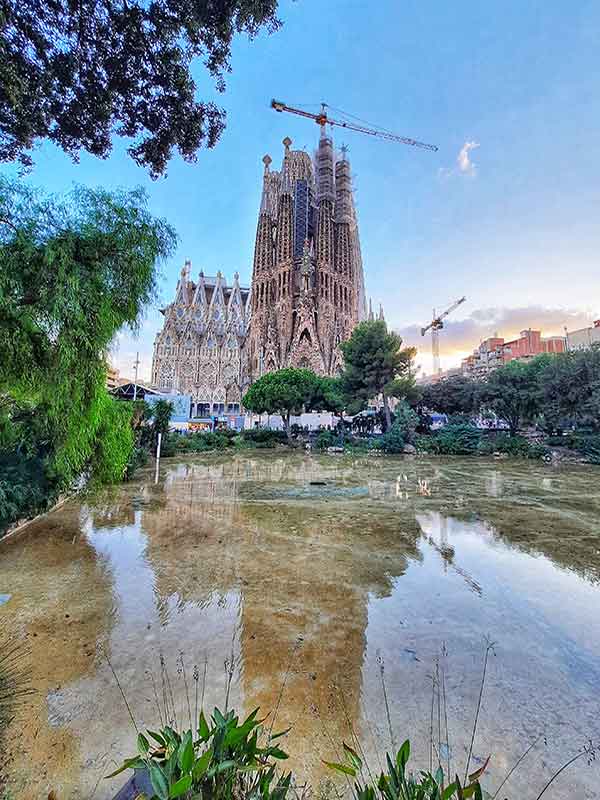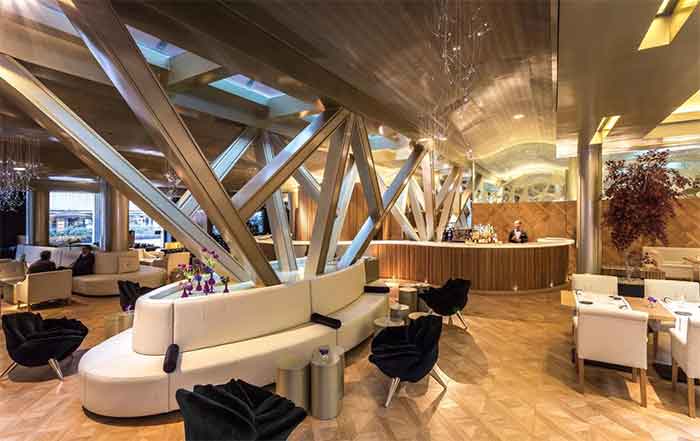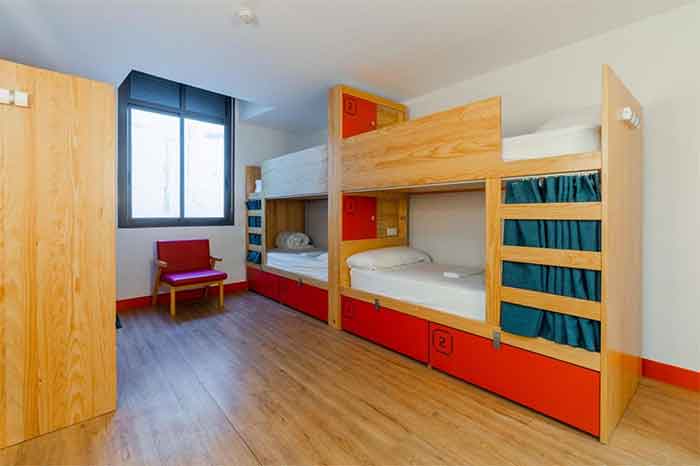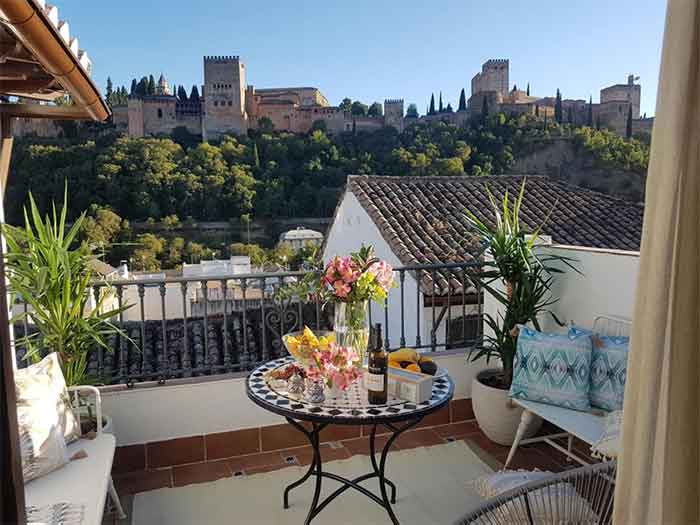Best Spain and Portugal Itinerary: 14 Days Guide
If you’re planning a trip to Spain and Portugal, this article is a great place to start. This detailed Spain and Portugal itinerary covers a multitude of highlights in a culturally packed 14 day trip. Not only is this article filled with my insider tips and practical details you’ll also find a downloadable map to get all this info sent straight to your mailbox.
Having lived in Spain for several years, I’ve had plenty of opportunities to explore the country and its neighbour.
So what can you expect in this two weeks Spain and Portugal itinerary? 14 days of cultural immersion, that’s what. It includes the two capitals; Madrid and Lisbon, fairy tale castles in Sintra, the UNESCO heritage sites of Cordoba, and the Alhambra and a whole lot more.
Read on and discover the best itinerary for Spain and Portugal in just two weeks.

Meet Me In Departures contains affiliate links and is a member of the Amazon Services LLC Associates Program. If you make a purchase using one of these links, we may receive compensation at no extra cost to you. See our Disclosure Policy for more information.
Best Spain and Portugal Itinerary 14 Days
This 14 day Spain and Portugal trip starts in Barcelona, Spain and finishes in Porto, Portugal. However, there’s no reason why you can’t do it in reverse.
14 Days in Spain and Portugal Overview
- Day 1 & 2: Barcelona, Spain
- Day 3 & 4: Madrid, Spain
- Day 5 & 6: Granada, Spain
- Day 7: Cordoba, Spain
- Day 8 & 9: Seville, Spain
- Day 10, 11 & 12: Lisbon, Portugal
- Day 11: Day trip to Sintra from Lisbon
- Day 13 & 14: Porto, Portugal
📍 Trip Highlights: The Best of Spain and Portugal 📍
- La Sagrada Familia and Gaudi’s Landmarks (Barcelona)
- The Gothic Quarter (Barcelona)
- Museo Nacional del Prado (Madird)
- Museo Nacional Centro de Arte Reina Sofía (Madrid)
- Palacio Real de Madrid (Madrid)
- The Alhambra Complex (Granada)
- Mosque-Cathedral (Cordoba)
- Cathedral of Seville and Giralda (Seville)
- Real Alcazar (Seville)
- Plaza de España (Seville)
- Alfama District (Lisbon)
- Mosteiro dos Jerónimos (Lisbon)
- Belém Tower (Lisbon)
- Pena Palace (Sintra)
- Porto Old Town (Porto)
- Douro Valley Vineyards Tour (Porto)
Spain and Portugal Itinerary Map
This map shows all the cities I’ve included in this 2 week Portugal and Spain itinerary. I’ve chosen these cities because they are well connected by public transport.
I go into detail on how to get around the two countries in the next section.
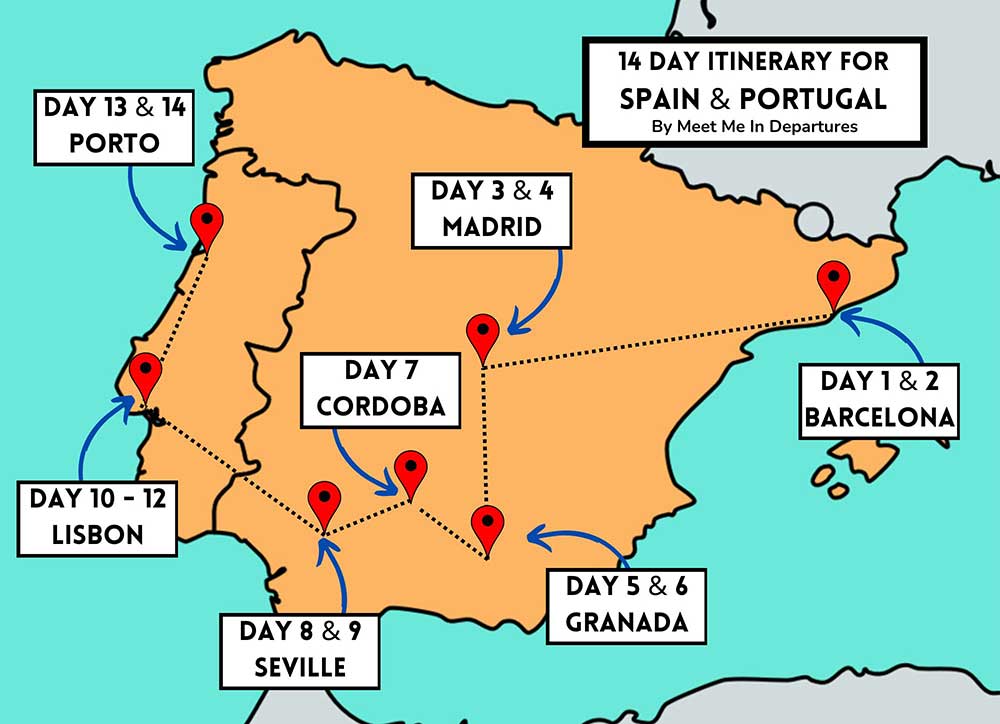
Related Articles
- How Many Days to Spend in Spain and Portugal?
- 50+ Epic Things To Do In Spain
- 36 Iconic Landmarks in Portugal You Need to Visit
Downloadable Spain & Portugal Itinerary Planner
This Portugal and Spain trip does involve a full-on schedule and although doable, if you have a longer time scale, or prefer a slower style of travel, then extend this itinerary to suit.
Use this itinerary planner to help organise and plan a trip to Portugal and Spain.
Trip Budget Calculator
The cost of this trip will vary a lot based on your travel style. If you’re travelling on a budget, then you could do it for less than Є2500, but if you’re looking to splurge a bit, then I would budget around Є4000 for two weeks.
To work out how much this Portugal and Spain travel itinerary might cost, use my trip cost calculator.
Planning Your Perfect Itinerary for Spain and Portugal
Before you start planning your itinerary for Spain and Portugal, here are some things you’ll want to think about.
How Many Days Do You Need in Spain and Portugal?
Spain and Portugal are two of the most popular destinations in Europe.
You could easily spend at least 2 weeks in Spain and 2 weeks in Portugal as individual trips, and barely scratch the surface.
I’ve put this two week guide together so that it covers the highlights of both countries in the quickest way possible.
When Is the Best Time to Visit Spain and Portugal?
If you are planning to visit Spain and Portugal, the best time to go is during spring or autumn.
The weather during these seasons is mild and pleasant, making it perfect for exploring and sightseeing.
Winters in parts of central Spain and western Portugal can be cool and wet – especially in Madrid, Lisbon and Porto. Whereas in summer, places like Seville, Cordoba and Granada can get insanely hot.
Getting Around in Spain and Portugal
These two weeks in Spain and Portugal have been based on public transport to get around and use a mix of;
- Trains
- Flights
- Bus
I’ve included information on how to do this in each section. To get the best deals, it’s better to book transport early. I use the Omio App, which can compare travel times and prices of buses, trains and flights.
Alternatively, you could opt to do this route as a road trip – however, I suggest extending this Spain and Portugal 2 weeks itinerary into a 3 week, or even a month-long trip due to the distances travelled.
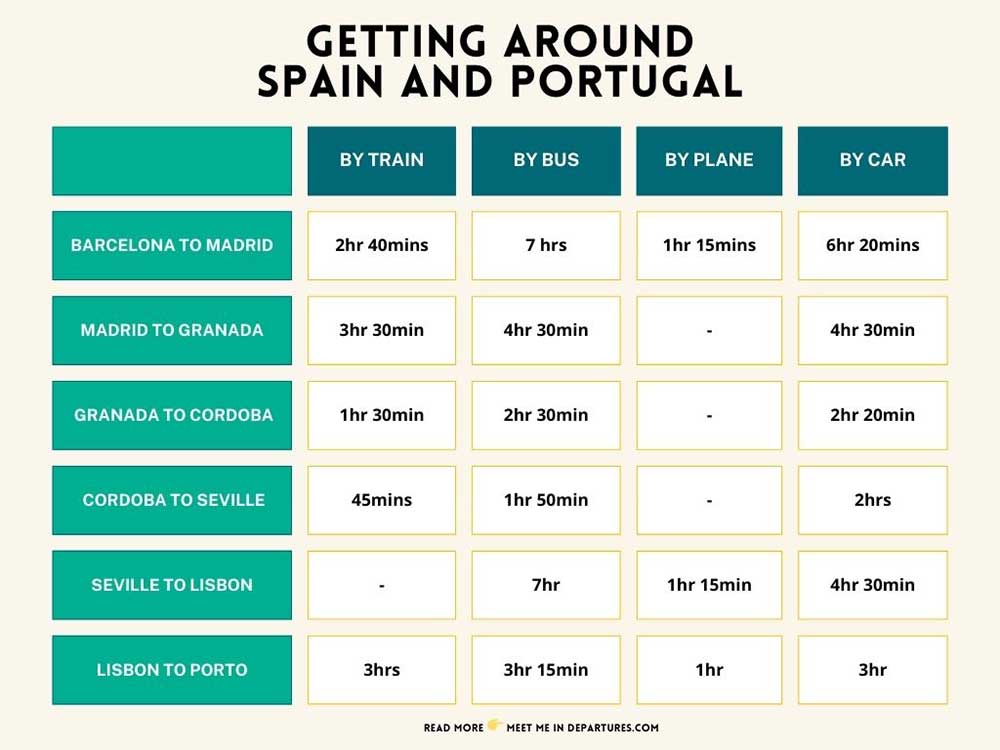
The Best 14 Days Itinerary for Spain and Portugal
Day 1 & 2: Barcelona
Top Things to Do in Barcelona
- Gaudi Architecture: Casa Milà, Casa Batlló and Park Güell
- La Sagrada Familia
- Montjuic Hill
- La Ramblas
- Mercado de La Boqueria
- Gothic Quarter
- Nightlife at El Raval and El Born
Your 2 week Spain and Portugal itinerary starts in the beautiful city of Barcelona. It’s home to some of the most beautiful architecture in Europe.
Allow two days in the city of Barcelona. This will give you enough time to see the highlights of Barcelona and get a feel for one of Spain’s most cosmopolitan cities.
Day 1 in Barcelona: Gaudí Day
Spend the first day visiting some of the iconic Gaudí buildings. Start with La Sagrada Familia.
Building work started in 1882. When Gaudí died in 1926, only about a quarter of the construction was complete. It’s still incomplete and clad in scaffolding, although they are hoping to finish construction in 2026 to mark the centenary of Gaudí’s death.
The UNESCO World Heritage site is heavily decorated in a mixture of Gothic and Art Nouveau styles. It’s covered in hidden and subliminal messages concealed in the details.
From Sagrada Familia, visit Casa Milà, Casa Batlló and of course, Park Güell.
All three of these get extremely busy, so start early in the day and book tickets in advance to skip the queue.
👉 Insider Tip: I’d definitely recommend booking your tickets for La Sagrada Familia as soon as you know your travel dates; they sell out fast! There are different options for tours; the roof tour is ok, but because it’s still being built, sometimes access and views are a little restricted/
I also suggest starting your day early to beat the crowds at any of Gaudí’s masterpieces. They are all popular, so expect queues and crowds.
📖 Read More: 32 Best Things to Do in Barcelona
Day 2 in Barcelona: Explore Old Town
Before the heat of the day, head to Montjuic Hill. If you’re not feeling energetic, then take a cable car up instead for amazing city views. It’s a great spot for photos!
In the afternoon, wander down La Ramblas, a lively street full of shops and performers. Then, dive into Mercado de La Boqueria for authentic Spanish street food – as a vegetarian traveller, there were plenty of options for food here.
Finish the afternoon by exploring the Gothic Quarter with its narrow streets and old buildings.
In the evening, I recommend the districts of El Raval and El Born, where you’ll find plenty of cool bars and nightlife.
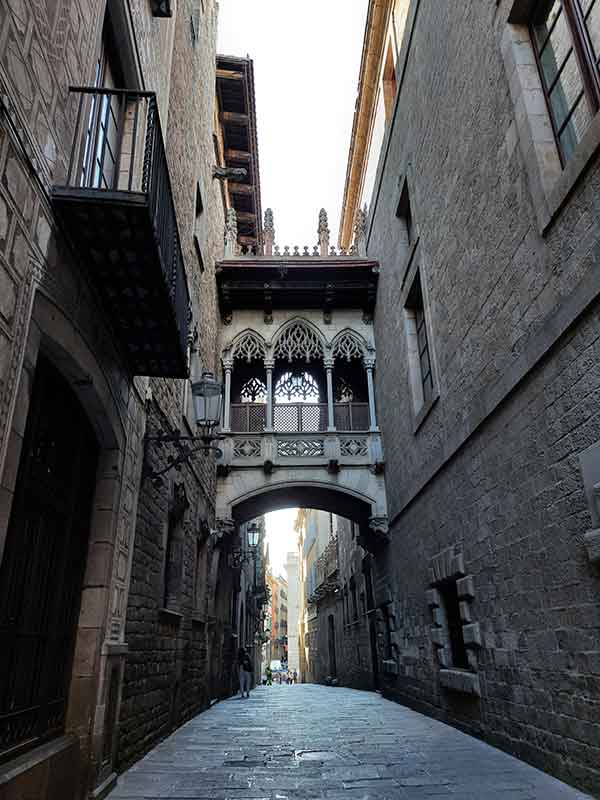

📖 Read More: 38 Most Famous Landmarks in Spain
Getting to Barcelona from Barcelona Airport
After arriving at Barcelona Airport, here are the best ways to get to the city centre.
- Taxi: I recommend this if you’re after convenience. Pre-book your taxi to take you straight to your hotel.
- Train (RENFE): Runs every 30 minutes from the Barcelona Airport to Barcelona Sants Station (Sants Estació).
- Aerobus: Quick and regular, with Aerobús A1 and A2 being your go-to options for the best service. This is usually the option I choose.
Where to Stay in Barcelona
⭐️⭐️⭐️⭐️⭐️
5* Monument Hotel, Barcelona
✅ Swimming Pool
✅ Central Location
✅ Sauna and Fitness Room
⭐️
Primavera Hostel, Barcelona
✅ Private or Dorm Room Option
✅ 8 minutes from La Sagrada Familia
✅ Wide range of facilities
Day 3 & 4: Madrid
Top Things to Do in Madrid
- Museo Nacional del Prado
- Museo Nacional Centro de Arte Reina Sofía.
- ‘Point 0’ in Puerta del Sol
- Gran Via
- Plaza Mayor
- Mercado de San Fernando and San Miguel.
- Parque El Retiro
- Palacio Real de Madrid
You’ll be spending 2 days in Madrid. This gives you enough time to explore some of the best museums in Spain as well as delve into some of the city’s beautiful architecture and cool hipster districts.
Day 1 in Madrid: Iconic Landmarks
Start your day at Puerta del Sol. This is the heart of the city (and Spain!), known as Point 0. You’ll find a plaque on the ground to show you the exact position. Then look up, and you’ll see the iconic Tio Pepe sign.
From there, walk to Plaza Mayor. This public square dates back to the late 1500s and was once home to Madrid’s main city market. If you’re interested in finding out more about the history of the city by joining a guided city tour.
One of the most opulent buildings in Madrid is the Palacio Real de Madrid (Royal Palace of Madrid). This is the official residence of the Spanish Royal family. It dates back to the 1700s, and if you’re into over-the-top grandeur, then it’s certainly worth a tour inside.
Opposite the Royal Palace, you’ll find the Almudena Cathedral (Santa Maria la Real de La Almudena). Construction on this building started in 1879, although it wasn’t finished until 1993! Check out the interior. I loved the vibrant paintwork here, giving it a Pop Art kind of feel.
In the evening, I recommend checking out the food market scene. San Fernando in Lavapiés or the hipster and upmarket one in San Miguel are both great options. Then finish off at the bars in the trendy Malasaña District.
👉 Insider Tip: If you’re after something a little more quirky, then I think you’ll love Chamberi/Anden0. Especially if you’re visiting the city in the off-season and looking to escape the cold, then this is one of the best things to do in Madrid in winter.
This abandoned metro station was closed off until recently. It’s now been reopened as a museum and looks just as it did back in the 1950s!
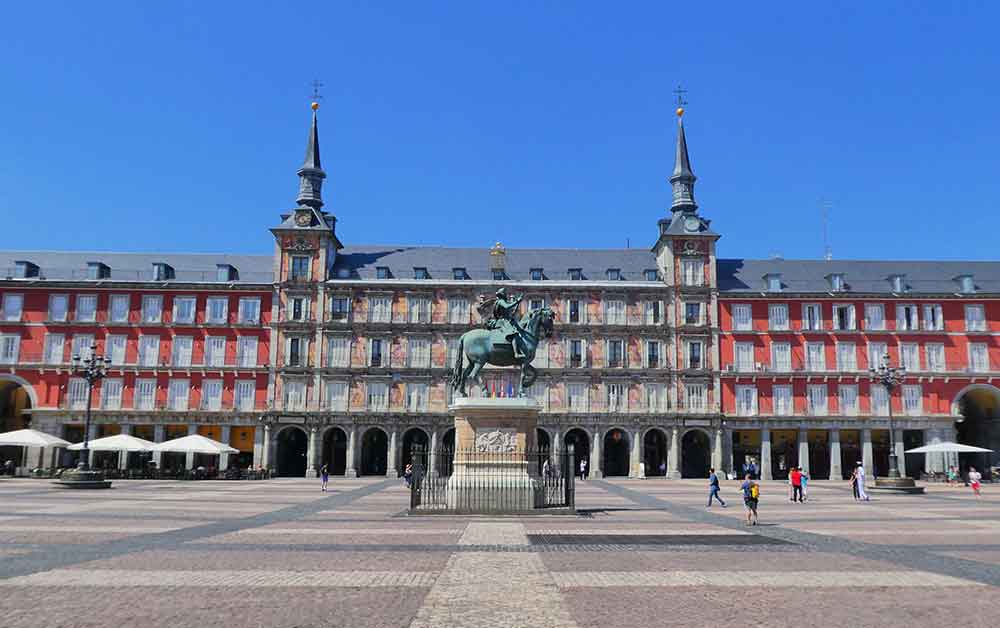
📖 Read More: Best Madrid 2 Day Itinerary: By A Local!
Day 2 in Madrid: City Culture
Start by exploring the city’s cultural scene. Three art galleries make up Madrid’s Golden Triangle of Art; the Prado Museum, (Spanish and South American Art) the Reina Sofia Museum (modern art, including Picasso’s Guernica masterpiece), and the Thyssen-Bornemisza for classical to modern European art.
After explore Parque El Retiro. It’s the biggest park in the city before heading down Calle Gran Vía – don’t miss the iconic Schweppes Building.
Finish your day in Barrio La Latina, known for its lively atmosphere and a great selection of bars – it’s also popular with the locals.
👉 Insider Tip: When you know your travel dates for Madrid, I strongly suggest booking your museum tickets early, especially for the Prado and Reina Sofía. These places are super popular and get crowded.
Madrid is also a sprawling city, so to make the most of your time I do recommend using the metro. This is the cheaper option. Alternatively, use the Madrid hop-off bus, which stops at all the major attractions without the hassle of navigating the metro system!


Getting to Madrid from Barcelona
It’s about 500km between Madrid and Barcelona. For this leg of the 2 week itinerary, you have a couple of options to make this journey.
- Train (RENFE): I recommend taking the train. The train is quick, around 2 hours 40 minutes, and leaves from Barcelona Sants to Madrid Atocha. Book your Madrid to Barcelona train ticket in advance for the best prices.
- Plane: Flights are roughly 1 hour and 15 minutes. However, keep in mind that you will have to factor in time for getting to the airport, check-in, security, etc. So overall travel time may not be much shorter than taking the train.
- Bus: Skip the bus; it takes over 7 hours. I don’t recommend this unless you are on a tight budget or have plenty of time to spare.
Where to Stay in Madrid
⭐️⭐️⭐️⭐️⭐️
5* Gran Hotel Ingles, Madrid
✅ Central location
✅ On-site spa and fitness centre
✅ 24-hour front desk
⭐️
Ok! Hostel, Madrid
✅ Wifi in all rooms
✅ Option for private or dorm room
✅ Central location
Day 5 & 6: Granada
Top Things to Do in Granada
- The Alhambra Complex
- Mirador San Nicolas
- Albaicín District
- Alcaiceria Bazaar
- Granada Cathedral
- Hammam Al Ándalus Arab Baths
Granada is home to one of the most stunning landmarks in Spain; the UNESCO Heritage Site and the Moorish complex of the Alhambra. I’ve allocated two days 14 day Spain Portugal itinerary to really do it justice.
Day 1: The Alhambra Complex
The complex is huge and there’s a lot to see in one day at the Alhambra.
It gets insanely busy, so I suggest starting early, having your Alhambra tickets booked in advance and being at the gate before it opens to avoid the crowds.
Your ticket will give you entrance to different areas of the complex. You can enter once at a time of your choice. For the Nasrid Palace, you’ll be given a time-allocated slot.
When I visited, I started my day at the Generalife so I could get gorgeous photos of the gardens without people in them.
After I did the Alcazar, I then had my timed Nasrid Palace visit – which is when you get to see the famous Patio de Los Leones, before finishing off with the Palace of Charles V and the remainder of the gardens.
📖 Read More: Complete 2 Days in Granada Itinerary
Day 2: Explore Granada City
Start your day two in Granada with a visit to Mirador San Nicolas. This viewpoint is where you get that stunning picture of the Alhambra complex against the backdrop of the Sierra Nevada Mountains. I’m not a morning person, but it was worth the early start to walk up there to take the photo and enjoy the lookout point without the crowds.
From there take a slow and meandering walk through the Albaicín District. This is one of the oldest parts of Granada, and another designated UNESCO World Heritage site. It’s easy to get lost here, in the narrow streets, but you’ll stumble on beautiful Arabic-inspired architecture.
In the afternoon focus on the city centre and the enormous Granada Cathedral.
If you’re looking for souvenirs, then I recommend the Old Silk Market, also known as Alcaiceria Bazaar – it’s opposite the cathedral.
Then finish your day with a relaxing soak at the Hammam Al Ándalus Arab Baths.
👉 Insider Travel Tips: I 100% recommend booking your Nasrid Palace and Alhambra tickets as soon as you know the data you’ll be in Granada The Nasrid Palace only has a limited number of admissions a day and is done on a time slot basis.
My other recommendation is to use the shuttle bus – it’s only a few euros and has a regular timetable. It departs from Granada town centre and drops off at the entrance of the site.

Getting to Granada from Madrid
- Train: This is the fastest way. It takes about 3.5 hours. About three services a day do the route from Madrid Atocha to Granada Train Station. I recommend booking early for the best prices.
- Bus: This is the cheaper but slower option. It takes over 4.5 hours and departs from Madrid Estacion Sur to Granada Bus Station. There are several services a day, some are direct, and others have a change. I’d only opt for this if you’re on a tight budget or not in a rush.
Where to Stay in Granada
⭐️⭐️⭐️⭐️⭐️
5* Haxaris Casa Boutique, Granada
✅ Panoramic city views
✅ Central Location
✅ Full living facilities
⭐️
TOC Hostel, Granada
✅ Private or dorm room option
✅ On-site bar and social areas
✅ Great location close to attractions
Day 7: Cordoba
Top Things to Do in Cordoba
- Mosque-Cathedral and Patio de Los Naranjos
- Historical Centre and Jewish Quarter.
- Colourful flower-laden patios and alleys
- Alcazar de los Reyes Cristianos
- Roman Bridge
Cordoba is blessed with an abundance of historical sites. These include the UNESCO-listed historical centre, the beautiful Alcazar stunning Mosque-Cathedral of Cordoba – also known as the Mezquita.
Although there are loads of things to do in Cordoba, you can see the highlights in one day.
Start with Cordoba’s Mosque-Cathedral. It seamlessly combines Moorish and Christan architecture. It’s filled with columned archways – 856 of them – which feature red and cream-coloured blocks.
Two of my favourite places here were the Capilla Mayor with its gigantic central dome and the intricate Marsura Dome.
📖 Read More: What To See In Cordoba in One Day
Don’t miss the Patio de Los Naranjos, which is one of the oldest parts of the building, and then go up the tower for a view looking down over the city.
After you’ve visited the Mezquita, explore the historical centre and the Jewish Quarter.
I recommend spending a couple of hours exploring the quaint cobblestoned alleyways and courtyards – don’t miss the Calleja de las Flores.
If you visit Cordoba at the start of May, then your visit will coincide with the Los Patios festival. During this time every courtyard, alleyway, and square is heavily decorated with flowers.
Another not-to-miss landmark is the Alcazar de Los Reyes Cristianos. Historically, this building has served both as a fortress and a palace. A few highlights to look out for here are the Hall of the Mosaics, the Arab baths and the Mudejar courtyards.
As the sun starts to set, walk over the Roman Bridge for a fantastic panoramic photo of the city.
👉 Insider Tip: To get the most out of a day in Cordoba, I recommend booking your tickets for Cordoba’s Mosque-Cathedral ahead of time – it can get insanely busy. Arrive early to beat the beat the crowds.
You can opt to explore the Mosque at your own pace, however, the downside I found was that there was a real lack of information about anything. The audio-guided tour of the Mosque-Cathedral is a great option if you prefer to explore at your own pace, but want the detailed insight of a guide.

Getting to Cordoba from Granada
- Train: This is the best option and takes around 1.5 hours. There are several departures a day leaving from Granada station and arriving at Cordoba Central. This is my go-to choice. Book trains in advance to secure the best price.
- Bus: The bus takes a bit longer, roughly 2.5 hours. There are a few departures per day from Granada Bus Station and arrive at Cordoba Bus Station.
Where to stay in Cordoba
⭐️⭐️⭐️⭐️⭐️
Balcón de Córdoba
✅ Rooftop terrace with Mezquita views
✅ Located in the historic centre
✅ 3 secluded patios for relaxation
⭐️⭐️⭐️
Eurostars Patios de Cordoba
✅ Set in a 12th century building
✅ Centrally located
✅ Mezquita views
Day 8 & 9: Seville
Top Things to Do in Seville
- Cathedral of Seville and Giralda
- Real Alcazar.
- Barrio Santa Cruz
- Plaza de España
- Parque de Maria Luisa
- Watch a Flamenco show
- La Casa de Pilatos
- The Metropol Parasol
Seville is a city bursting at the seams with beautiful architecture, and stunning landmarks. It’s home to plenty of UNESCO World Heritage sites and of course the home of flamenco.
I’ve lived in Seville for several years, and although I’ve dedicated two days in this Portugal Spain itinerary to the Andalucian capital, I do recommend spending at least three days in Seville to absorb everything.
Day 1: Historic Seville
Spend day 1 exploring the historical centre. This includes Seville Cathedral and the Girlada, Real Alcazar and Barrio Santa Cruz; the old Jewish District.
The Real Alcazar is my favourite landmark in Seville, so I suggest putting it at the top of your Seville Bucket List as it gets extremely busy.
The Alcazar has a limit of around 750 visitors a day, so at peak season, these do sell out. So make sure you book your ticket tickets for the Real Alcazar in advance.
Inside the Alcazar, my favourite places were the Salón de Embajadores (Ambassador’s Hall), and the Patio de las Donacellas (The Courtyard of the Maidens). The gardens are also huge, so I’d allow at least 2 or 3 hours to do this the Real Alcazar justice.
📖 Read More: A Local’s Guide To Seville
After the Real Alcazar, visit Seville Cathedral. Here you’ll find the tomb of Christopher Colombus. You’ll also get to climb the Giralda Tower. This part of the cathedral dates back to when Seville was under Arab rule and used to be the minaret of a mosque.
👉 Useful to Know: If you love ornate cathedrals, like the one in Seville, and you’re visiting Spain for an extended amount of time, then check out the equally stunning cathedral facade of San Sebastian in the Basque country.
Spend the remainder of the day exploring the labyrinth-like streets of Bario Santa Cruz.
Seville has deep roots in its folklore. This heavily influences its music and dance. If you want to experience Spain authentically, then take the opportunity to watch a Flamenco show in its birthplace in the evening.

📖 Read More: 35+ Best Things To Do In Seville
Day 2: Seville Landmarks
On your second day, starting at the gargantuan Plaza de España. It was built in 1929 as part of an Expo, it’s free to enter – there is talk of charging for entry – and features beautiful tile work depicting all the provinces in Spain.
If you love the tile work in Seville, then I recommend adding in a trip to Triana district across the river, to see the factory where they were traditionally made.
Next to Plaza de España, you’ll find Parque de Maria Luisa.
To finish the afternoon, explore some of the photogenic old palaces dotted around the city; La Casa de Pilatos is my top suggestion.
As the sun sets, go up the Metropol Parasol – affectionately known as Las Setas or “the Mushrooms” in English thanks to their shape. Then head up to Alameda de Hercules for tapas and drinks.
👉 Alternative Suggestion: If this 14 day itinerary feels too rushed, then you might prefer this 7 day road trip in Andalucia, and sticking to just one region instead.
An alternative plan; because Cordoba is a city near Seville, you could skip staying overnight in Cordoba. Stop in Cordoba for the day en route from Granada to Seville.
If you’re craving the sea and sand, then use one of the days in Seville to check out some of the coastal regions – Cadiz is a great option, but there are plenty of other great beaches close to Seville.

Getting to Seville from Cordoba
- Train: The quickest way to Seville from Cordoba, taking under an hour. Trains depart several times a day from Cordoba Central to Santa Justa Station in Seville. I recommend booking early for cheaper tickets. Santa Justa is a little way out of Seville city centre, so when you arrive take either a taxi or a bus to the centre the airport shuttle makes a stop here – look out for the AE service.
- Bus: A slower option, taking just under two hours. Buses go from Cordoba Bus Station to Plaza de Armas in Seville. There are several services a day.
Where to stay in Seville
⭐️⭐️⭐️⭐️⭐️
5* Hotel Alfonso XIII Hotel, Seville
✅ Rooftop swimming pool
✅ Centrally located historic building
✅ Variety of on-site bars and restaurants
⭐️⭐️
Petit Palace Vargas, Seville
✅ Modern and clean decor
✅ Great location
✅ Excellent breakfast
👉 Good to Know: Did you know that you can see Morocco from Spain’s southern coast? They are a mere 14km apart.
If you’ve enjoyed the Moorish architecture of Granada, Cordoba and Seville, then I highly recommend visiting Morocco.
And if you have time, then you could tag on a day trip to Morocco from Spain. To get there, take the ferry from Tarifa on the south coast for the 90-minute crossing to Tangier.
Alternatively, check out this organised day tour to Morocco from Seville.
Day 10, 11 & 12: Lisbon and Sintra
Top Things to Do in Lisbon
- Praça do Comercio
- Arco de Rue Augusta
- Lisbon Cathedral
- Alfama District
- São Jorge Castle
- Santa Justa Lift
- E28 Yellow Tram
- Eat Pastel de Natas
- Carmo Convent
- Mosteiro dos Jerónimos
- Belém Tower
You’ve finally made it to the Portuguese leg of this 2 week itinerary.
I’ve allocated three days in the nation’s capital. You can easily see the main highlights of Lisbon in 2 days, and then there’s one day dedicated to a Sintra.
Day 1: History and Culture
If you wondering why visit Lisbon, you’ll be glad to know that in this relatively small city, you’ll find an abundance of history, adorable barrios and delicious food.
On your first day in Lisbon, start in the Praça do Comercio (Commerce Square). This is one of Lisbon’s most recognisable landmarks with the iconic yellow Arco de Rue Augusta on one side and the Targus River on the other. This square is also where most of Lisbon’s walking tours start.
👉 Insider Tip: If you’re lucky and time it right, you can get a gorgeous photo of the yellow Arco de Rue Augusta with one of Lisbon’s signature yellow trams trundling past. Another of my favourite photo spots is on the corner of the cathedral – wait here and you’ll get a photo of the yellow trams going past.
From here visit Lisbon Cathedral and meander your way up through the oldest part of the city; Alfama District. You’ll probably spend a decent amount of time getting lost in these streets which ooze with history. Eventually, if you keep heading upwards, you’ll come out to São Jorge Castle.
From there, head back down going via Bairro Alto where you can find street art. I also recommend taking a ride on the famous E28 Tram.
After, visit the Santa Justa Lift. Take the lift to the upper part of town and visit the ruins of the Carmo Convent.
In the evening catch the metro over to the Time Out Market to eat your way around stalls selling local artisan foods.
📖 Read More: The Best 2 Days in Lisbon Itinerary
Day 2: Sintra Day Trip
Sintra is where you’ll find some of the most beautiful castles in the whole of Europe and one of the easiest day trips from Lisbon.
I’ll go into Sintra in more detail in the section below.
Day 3: Lisbon Landmarks
On the third day, pick up the local train to two of Portugal’s most beautiful landmarks: Mosteiro dos Jerónimos and the Belém Tower.
Both sites have UNESCO World Heritage status.
Start with the Mosteiro dos Jerónimos – it’s one of the most important monasteries in Portugal and a must-visit for history lovers.
Make sure to also try the famous Pastéis de Belém while you’re in the area.
Hang about Belem Tower until sunset – it looks stunning in this light and is popular at this time of day with locals and tourists.
👉 Insider Tip: Lisbon is a hilly city, and lots of the attractions in Lisbon are fairly spread out.
If you’re not keen on walking to each of the landmarks or navigating the metro system then opt for the Lisbon hop-on-hop-off bus which will pick up and drop you off at all the locations I’ve mentioned.

📖 Read More: 36 Most Famous Landmarks in Portugal
Getting to Lisbon from Seville
The city of Seville is well connected to Lisbon, by bus and plane – there is no direct train route.
- Bus: Catch an overnight bus from Seville’s Plaza de Armas to Lisbon Oriente. This direct bus takes about 7 hours, saves a night’s accommodation, and is super budget-friendly. I recommend booking early to get the best deals.
- Flight: For a quicker option, you can fly from Seville Airport to Lisbon Portela. It’s just over an hour and there are several flights daily. Use the airport shuttles at both ends to get to and from the city centres easily. Booking in advance to get the best prices.
Where to Stay in Lisbon
⭐️⭐️⭐️⭐️
4* AlmaLusa Baixa, Lisbon
✅ Renovated 18th century building
✅ Located next to Rossio Square
✅ Each room has unique decor
⭐️
This Is Lisbon Hostel
✅ Private or dorm room option
✅ Roof terrace with panoramic views
✅ Daily breakfast, and kitchen facilities
Day 11: Sintra Day Trip From Lisbon
Top Things to Do in Sintra
- Pena Palace and Gardens
- Castelo dos Mouros
- Sintra Old Town
- Quinta da Regaleira
- Palácio de Monserrate
Just a short distance from the capital, you’ll find thick and luscious green forests and rolling hills, Dotted between you’ll find fairy-tale castles which look like they’ve been plucked straight from a Disney film set.
Start your day trip to Sintra early as it does get very busy.
Start with Palacio da Pena. Spend time exploring the incredible interior of this 19th-century Romanticist palace. It mixes vibrant colours with geometric patterns and sits within well-manicured gardens.
📖 Read More: How to Do a Lisbon to Sintra Day Trip
After visiting the palace, head over to the visit the Castelo dos Mouros. This Moorish Castle dates back to the 8th century and gives stunning panoramic views of Sintra and its surroundings – on a clear day you can see all the way to the Atlantic Ocean.
From the Moorish Castle, head back down to Sintra Old Town and straight through to Quinta da Regaleira.
I absolutely loved it here and spent far too long exploring the gardens and the house. Quinta da Regaleira features Gothic-style architecture. Gargoyles, balconies and grottoes fill the grounds.
It was designed as an aristocrat’s playground with terrace gardens, folly castles and towers, underground mazes and the iconic Initiation Well. Head to the Initiation Well first.
If you have any time left on your day trip to Sintra, then I also recommend a quick visit to the Moorish-influenced Palácio de Monserrate.
Finish off at Sintra Old Town – although it’s small, it has some very cute little alleyways. Finally, catch the train back to Lisbon.
👉 Insider Tip: To avoid the queues at Sintra, I recommend booking skip-the-line tickets in advance!
Several full-day tours include transportation and priority access which is a more efficient way to visit the area.
Getting to Sintra from Lisbon
Bus: Take the train from Lisbon’s Rossio Station; it’s about a 40-minute ride. Once in Sintra, take the shuttle buses 434 or 435 to get to the main attractions without wasting time.
Organised Tour: If you’re after an easier way to do it, then take a look at this full day tour from Lisbon to Sintra, it includes all your transportation.

Day 13 & 14: Porto
Top Things to Do in Porto
- Porto Old Town
- Livraria Lello
- Clérigos Church
- Azulejo tiles at Porto Sao Bento Train Station
- Luis I Bridge
- Douro Valley Vineyards Tour
We’ve reached the last stop on your 2 weeks in Spain and Portugal itinerary: Porto!
This city is all about exploring by foot with plenty of stops to sip on a glass of delicious local port wine.
Day 1: Porto Old Town
Start in the Porto Old Town
Porto is the second-largest city in Portugal, after Lisbon, and is a hub for great food and drink.
It’s best to explore the historical centre on foot so it gives you plenty of opportunities to stop off and try the local wine.
If you’re a Harry Potter fan, then don’t miss Livraria Lello. It’s said that it was part of the inspiration for JK Rowling’s magical world. Even if you’re not a fan of the series, the iconic library is still worth a visit to see the pretty spiral staircase and ancient books on the shelves.
From there, I recommend visiting the Clérigos Church – an ornately decorated Baroque church. Climb up the narrow tower for a fantastic view of Porto.

From the church, head up towards Miradouro da Vitoria, for a different panoramic lookout point. If you love beautiful architecture, then it’s also worth taking a guided tour of the Palácio da Bolsa.
Another must-see in Porto is the beautiful Azulejo tiles at the Porto Sao Bento Train Station.
Finish your day with a walk across the Luis I Bridge.
This is one of the top landmarks in Portugal. The bridge has become a bit of an icon to the city, which connects the two sides. You have the option of walking across on the upper level or the lower level – both give great views of the city, especially at sunset.

Day 2: Douro Valley Wine Tour
The best way to experience the Douro Valley is by booking one of the full-day wine tours from Porto.
There are typically two ways to do one of these small group tours, by mini-van or by riverboat – I opted for the boat tour.
Both types of tours will stop at various vineyards where you’ll have a short tour of the vineyard or factory and then get to try a variety of their locally produced wines and ports. You can then buy bottles (or cases) directly from the sellers to enjoy back home.
👉 Insider Tip: Make sure to pack some snacks and water for the boat tour for starters, it can get quite warm on the river.
Also, I know after all the samples of wine – I definitely got the munchies way too early in the day. Don’t make my mistake, eat a huge breakfast AND bring snacks.
Getting to Porto from Lisbon
- Trains: Catch the direct train from Lisbon Oriente to Porto Campanh. The journey time is about 3 hours. Book tickets in advance for the best prices.
- Bus: These depart from Sete Rios Station and arrive at Oporto Campo 24 Agosto. The direct bus takes just over 3 hours. Compare prices for bus and train.
- Plane: The flight takes around 1 hour and departs from Lisbon Portela Airport. departs Porto Airport. There are shuttle services between the city centres and the airports.
Where to Stay in Porto
⭐️⭐️⭐️⭐️⭐️
5* Torel 1884 Suites & Apartments
✅ Exceptional breakfast
✅ Central Location
✅ Rooms come with a patio or city views
⭐️
Being Porto Hostel
✅ Private or Dorm Room Option
✅ 8 minutes from La Sagrada Familia
✅ Wide range of facilities
Spain Portugal Itinerary 14 days – FAQs
How Many Days Do You Need in Spain and Portugal?
The answer depends on your travel style and of course, how long you have to travel. Generally speaking, spending at least 10-14 days in these two countries will allow you to see the major highlights.
This two-week itinerary for Spain and Portugal is designed to help you explore the highlights of both countries efficiently. If you prefer a slower pace, you can extend this itinerary to a month.
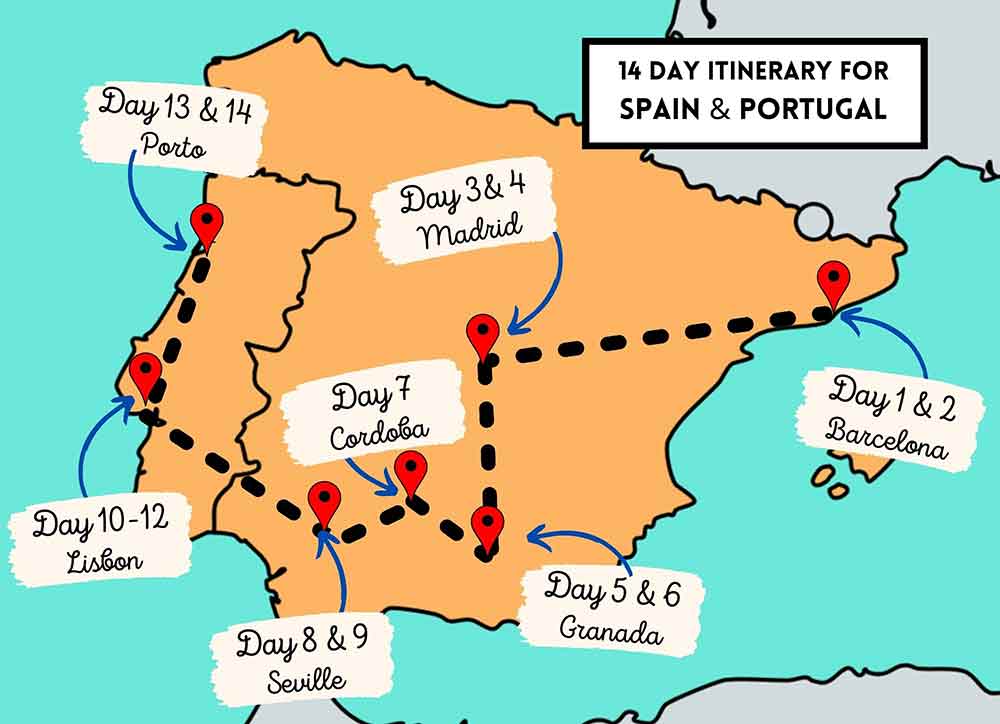
What Is the Best Time to Visit Spain and Portugal?
The best time to visit Portugal and Spain is during the spring (March to May) and autumn (September to November) months.
Peak prices and crowds are in July and August and Easter in March/April is also busy. Winters can be cold and even wet in places like Madrid, Lisbon and Porto.
How Much Will This Spain Portugal Trip Cost?
This will vary greatly depending on your travel style and if you’re travelling on a budget or plan to splurge a bit. I would budget anywhere between Є2000 to Є4000 for two weeks.
For a more accurate idea, use my trip cost calculator to work out how much it will cost.
Should I Visit Spain or Portugal First?
Essentially it doesn’t really matter if you travel to Spain or Portugal first. I would say, check which airports are the easiest to get to and base it on that. It might be easier for you to do this itinerary from Portugal to Spain instead, and then work backwards.
Can I Do This Itinerary as a Spain and Portugal Road Trip?
I don’t recommend doing this exact itinerary as a road trip in Spain and Portugal unless you want to spend a large portion of the two weeks behind the wheel. Although the two countries share a border, the overall Spain to Portugal distance this itinerary covers is too much for just 14 days.
You could follow the same route, but plan for extra days and stop off in lots of the smaller towns in between the main cities.
Head over to Andalucía Explored, which is a site dedicated to road-tripping in the Iberia region for some great ideas.
What Is Driving Like in Spain and Portugal?
Driving in both of these countries is straightforward. Roads are generally well maintained with good signposting and outside of the cities traffic is minimal. Some roads do have a toll on them, which is something you should be aware of.
Before you get behind the wheel, it’s worth reading up on the highway code if you’re not familiar with driving in Europe.
📖 Read More: Road Trip Essentials Checklist
What’s the Best Way to Get Around Portugal and Spain?
Spain & Portugal have a well-developed public transport system, making it easy to get around the countries without a car.
Both countries have an extensive network of trains, buses, subways, and flights that connect major cities and towns. One app that I’m obsessed with for comparing transport times and prices is Omio.
Packing for This Trip
The weather in Portugal and Spain varies a lot – this goes for the different locations as well as the time of year. Even in summer, I would say it’s wise to take a lightweight jacket, and in winter you’ll definitely need a thick jacket – it can snow in Granada and Madrid!
When you travel to Spain and Portugal, I suggest checking the weather in each location before you pack.
Are There Any Small Group Tours That Offer a Similar Trip?
Yes. If you’re not into solo travel, or you prefer the convenience of everything done for you, then small group tours are a great way to travel.
Here are two great options for Spain and Portugal tours:
14 Day Best of Spain & Portugal Small Group Tour
21 Day Ultimate Spain & Portugal Small Group Tour
Can I Visit Morocco From Spain?
Yes! You can easily tag on a trip to Morocco, especially from the South of Spain. From Seville, you can fly to Morocco in less than an hour, or if you’re driving, catch the ferry over from Algeciras or Tarifa on Spain’s southern coast, and arrive in Tangier in the north of Morocco.
And there you have it, a whirlwind two weeks in Spain and Portugal. As I said at the start, this is a fast-paced trip which packs in so many highlights from both these countries in the most efficient way.
Although I generally prefer slower travel, I totally get that sometimes you’ve only got limited time to pack in as much as possible. I hope this itinerary for Portugal and Spain helps you make the most out of your trip.
Ready to plan your trip, then check out these other articles about Spain and Portugal and get started today.
General Spain Travel
- Ultimate 10 Days In Spain Itinerary
- 2 Week Spain and Portugal Itinerary
- How Many Days Should I Spend in Spain and Portugal?
- 50+ Best Experiences for Your Spanish Bucket List
- 38 Most Famous Landmarks in Spain
- Can You See Morocco From Spain?
Madrid And Surrounding Area
- Is Madrid Worth Visiting?
- 28 Best Things to Do in Madrid, Spain
- Best Madrid 2 Day Itinerary By A Local!
- 30 Things to Do In Winter in Madrid
- Madrid vs Lisbon Comparison Guide
- How to Visit Segovia From Madrid in a Day
- A Day Trip to Toledo from Madrid
Madrid And Surrounding Area
- Is Madrid Worth Visiting?
- 28 Best Things to Do in Madrid, Spain
- Best Madrid 2 Day Itinerary By A Local!
- 30 Things to Do In Winter in Madrid
- Madrid vs Lisbon Comparison Guide
- How to Visit Segovia From Madrid in a Day
- A Day Trip to Toledo from Madrid
Andalucia and South Spain
- Southern Spain Itinerary: Best 7 Days in Andalucia
- Local’s Guide To Seville in 3 Days
- 35+ Top Things To Do In Seville
- 23 Best Day Trips From Seville, Spain
- How to Do A Seville to Cordoba Day Trip
- Where Is the Nearest Beach to Seville?
- How To Spend One Day in Granada
- Best 2 Days in Granada Itinerary
- The Best Cordoba in One Day Itinerary
- 5 Places for the Best Glamping in Spain’s Southern Coast
Portugal Travel Tips
- 2 Week Spain and Portugal Itinerary
- How Many Days in Spain and Portugal?
- The Best 2 Days in Lisbon Itinerary
- Most Famous Landmarks in Portugal
- Should You Visit Barcelona or Lisbon?
- Should You Visit Lisbon or Madrid?
- The Best 2 Days in Lisbon Itinerary
- 18 Best Things to Do in Lisbon in the Rain
- How to Do a Lisbon to Sintra Day Trip
- 16 Great Reasons to Visit Lisbon

